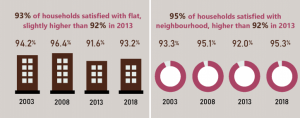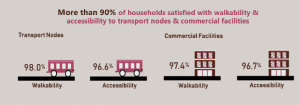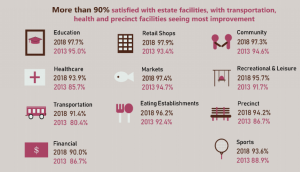Playing catching under the block, (illegally) kicking a ball around the void deck, running towards the sound of the ice cream bell…ahh memories. Being overly attached to your neighbourhood (I’m looking at you “EAST SIDE BEST SIDE” people) is part and parcel of growing up in Singapore. After all, it’s not like we have states or big cities to go by.
To ensure better homes for all, the Housing Development Board (HDB) conducts the Sample Household Survey (SHS) to gain a keener understanding and take feedback from residents across the country.
HDB Sample Household Survey
The HDB Sample Household Survey has been conducted every 5 years since 1968, and the results of the most recent survey conducted in 2018 have been published on Sunday, 14 February.
Nearly 8,000 households had participated in the survey and were from all types of estates.
If you would like to take a look at the survey itself (mind you, it’s 248 pages long), you can check out the HDB website.
Population and Household Demographics
Most prominently, the number of Singaporeans and permanent residents living in HDBs has decreased from 3.06 million in 2013 to 3.04 million in 2018.
According to the survey, the decline was “mainly due to net outflow of HDB resident population into private housing” despite the rise in the number of HDB flats.
Currently, while the majority of the HDB resident population lives in sold flats, the number of residents who live in 1- and 2- room flats has increased over the last decade due to more rental flats and smaller flat types being supplied to accommodate the increase in demand.

An interesting change to note is that while family-based households make up the majority of household types, they have decreased over the last five years. Now, more than one in eight households are non-family based—double the amount since 1998.
The SHS also reports that Woodlands, Jurong West, Tampines and Sengkang were the most populous towns in Singapore, housing over 200,000 persons respectively.
We have the northies, westies, easties and north-easties.
Of course, the south isn’t included because it’s the boujee town area where us plebs can’t afford to stay.
Sengkang, Punggol and Sembawang are also considered young towns, with high populations of young families. Those under 15 years old make up 21.2%, 25.3% and 18.2% of the town’s population respectively.
Family and the Elderly
According to CNA, HDB had said that “The SHS (Sample Household Survey) findings showed that proximity facilitated family interaction, caregiving and provision of support”.
Especially since elderly persons constituted 16.5% of the total resident population, there was a need to ensure that housing allowed families convenience in giving support to their aged parents.
The percentage of younger married couples that live nearby or in the same estate as their parents had risen from 42.8% in 2013 to 44.9% in 2018. More aged residents are also living closer to their children in recent years.
For couples that live in close proximity to their parents, the vast majority of them visited each other at least once a week.
CNA also reports that strong family ties continue to persist, with both younger married couples and older residents with married children being over 98% satisfied with their familial relations.
Married children were often the main caregiver for their parents, providing them with emotional, physical and financial support.
The Housing Board notes that the findings are “important to understand how the HDB living environment could be improved to enhance the physical, mental, and emotional well-being of residents as they live through their silver years.”
Housing Satisfaction and Preferences
Onto the next half of the survey, and the headline that clickbaited you in.
The latter covers residents’ experiences with their physical environment in their neighbourhoods and aims to assess their housing needs and even car-lite readiness in HDB estates.
The findings show that resident satisfaction with their flat has increased slightly from 92% in 2013 to 93% in 2018. Overall, residents are extremely pleased with their physical living environment, since at least nine in 10 are satisfied with the flat, neighbourhood, accessibility and walkability.


HBD also explained that those who were dissatisfied with their flat mainly faced issues with the condition of their flat, having spalling concrete and ceiling leaks.
Satisfaction with the neighbourhood also increased from 92% to 95.3% in 2018, with residents expressing that they liked the convenient location, having friendly neighbours or a peaceful environment.
In addition, there was a greater sense of belonging among residents who were satisfied with the neighbourhood. A high of 99% was polled in this survey.
Estate and its Facilities
Apart from the neighbourhood, HDB also sought out residents’ view of their facilities and estate. A record 98.6% of residents polled were satisfied with their estate facilities, citing that transport, healthcare and precinct facilities had improved the most.

The Housing Board credited the Bus Service Enhancement Programme, the expansion of the MRT network, the Enhanced Appointment System and the Community Health Assist Scheme for providing better services to residents.
However, the SHS found that there was a fall in the usage of commercial facilities (except for supermarkets) by HDB residents, “likely due to the increasing trend of online shopping and food delivery services”.
To learn more about HDB residents’ shopping preferences and neighbour interactions, click here.
See any familiar places? Here are the top 3 hangout spots in HDB estates. Who knows, perhaps you’re reading this in one of them right now!

Residents’ Travel Patterns
Unless you’re really lucky, we all know the hassle of travelling to work. That’s why HDB wants to find out about residents’ daily commute to “throw some light on possible gaps that need to be addressed to improve transport connectivity.”
The survey results show that more residents have to travel beyond the area they live into work, which comes as no surprise. This is so because most residents made residential movements based on life events and life cycle changes (39.9%) rather than to gain accessibility to their place of work (5.5%).
The majority of residents still use public transport to commute to work, and only less than 20% used any kind of car-based transport mode.
HBD added that findings from the Land Transport Authority’s (LTA) Household Interview Travel Survey show that household proximity to a train station increased the likelihood to use public transport and the likelihood of car-ownership among those residents were also observed to be lower.
As for students, almost half of the student population attended school in the same town they were in and 54.9% used public transport for their commute.
Nonetheless, HDB stated that “Although car ownership had decreased over the past five years and despite the high costs, the proportion of residents utilising private vehicles for travel to work and school was still higher compared with other modes for reasons of convenience.”
Perhaps more car-lite towns would have to wait a little longer.
New section in Sample Household Survey
The survey in 2018 was also the first time HDB had asked residents for feedback on places that held special memories for them. 23.2% of residents had fond memories of their places in their towns, pointing to HDB blocks, parks or gardens.
Another new and very appropriate section would be the recycling habits of households. However, HDB found that more than half of the residents did not recycle regularly.
As for households which practice recycling, only a small proportion disposed of them in the allotted centralised cute. This was due to such chutes only being present in newer blocks.
How it Helps to Define Policies
As HDB has repeatedly mentioned, the results provide essential feedback from residents so that it can effectively construct policies that will improve the residents’ living experience.
“…the findings provide useful feedback for HDB to chart the future directions of public housing, not only in formulating relevant housing policies, but also in refining its designs to meet residents’ needs,” said Associate Professor Tan En Ser, who is also the chairperson of the HDB Research Advisor Panel.
The Housing Board promises to continue gathering feedback and improve on the built environment to fully cater to their residents.
Featured Image: happycreator / Shutterstock.com




